The "La Peregrina" Pearl
Part 2
In 1808, Napoleon invaded Spain, crushing the Spanish and placed his older brother Joseph Bonaparte on the Spanish throne. Joseph ruled for 5 years until defeated by the Duke of Wellington in 1813, which meant he had to flee Spain. He took with him some of the Royal Spanish jewels, including the Peregrina Pearl. It was at that time, the pearl got its name "La Peregrina - the Wanderer."
After the final fall of Napoleon Bonaparte in 1815, his brother Joseph Bonaparte emigrated from France to the United States (where he sold the jewels of the Spanish crown he had stolen when he left Spain). He died in Florence in 1844 and passed the Pearl to his nephew Charles Louis Bonaparte.
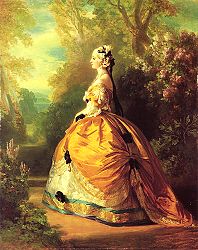 Empress Eug nie |
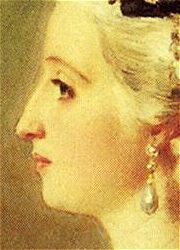 close-up with the Pearl |
However, young Charles too was to become a big name in history. He stole the French presidency in 1848 and in 1852, after another coup, he announced himself the emperor of France as Napoleon III. He married Eugénie de Montijo, a Spanish countess, educated in Paris. On the left is a Winterhaler portrait from 1854, in which she wears the pearl as an earring. |
| Before dying in 1873 Napoleon III sold the Pearl to Lord James Hamilton, born in London in 1811. He was the great-great-great grandfather of Diana, Princess of Wales. He bought it for his wife Louisa Jane. See right. The pearl remained in the Abercorn family for over a hundred years until it was placed with Sotheby's for an auction sale in 1969. |
 |
Richard Burton purchased the pearl at the Sotheby's auction in 1969 for $37,000. He gave it to his wife Elizabeth Taylor as a Valentine's Day gift and their 5th (first) wedding anniversary.
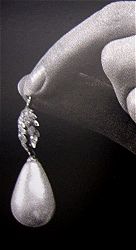 |
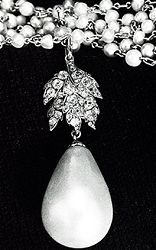 |
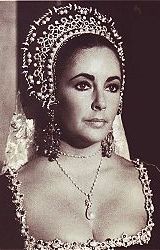 |
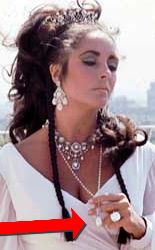 |
At the time Burton purchased the "La Peregrina" it was suspended as a pendant to a simple delicate pearl linked necklace. That was still not grandiose enough for them. They had seen a photo of a Queen Mary Tudor painting, wearing the pearl in an elaborate necklace and three years later they approached Cartier, with the photo, to have something very similar made.
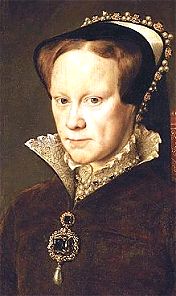 by Eworth |
 |
The designer of Cartier shuttled between their New York boutique and the couple’s yacht in London with sketches and worked with Elizabeth on the final design (see above). Cartier designed and fabricated a pearl choker with rubies and diamonds, which incorporates the La Peregrina as a drop from the original diamond bale. The result was a masterpiece of pearls, rubies and diamonds. See the pictures below.
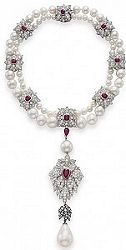 Click to enlarge |
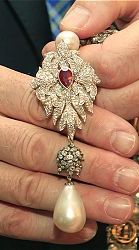 |
 |
>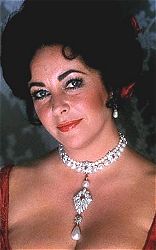 |
Christie's Auction and Provenance:
The late Elizabeth Taylor's jewelry will be auctioned at Christies on December 13 and 14, 2011.
The "La Peregrina Pearl" necklace has been allotted Lot No. 12 in the auction catalogue and has been titled "La Peregrina, a Natural Pearl, Diamond, Ruby and Cultured Pearl Necklace, by Cartier".
The La Peregrina Pearl is accompanied by a report, bearing No. 59574, dated May 19, 2011, issued by the Swiss Gemmological Institute, confirming the authenticity of this saltwater natural pearl, and an additional letter from the same institute, describing the unique rarity and exceptional historic provenance of the La Peregrina.
From Christie's website 12/5/2011 |
Fernando VI (1746-1759) |
Reason for the Selection of the Paintings in this Paper: |
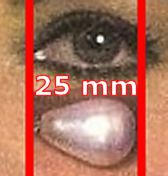 |
Were there other pearls of the same size?
This list shows the largest, pear-shaped, white-colored pearls. It also shows when and where the pearls were discovered.
One can conclude that in Europe, and at that time, there were no other pearls of the size and quality of the La Peregrina.
Which painting did not make the grade for this paper?
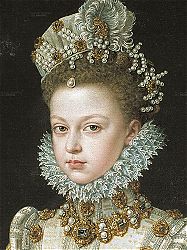 |
On the left is my favorite painting of this article, but it did not quite make the grade. Isn't she a cutie? Any guesses who she is? It is Infanta Isabella Clare Eugenia. She is 13 years old. |
Willem van Osnabrugge
December 5, 2011